| Bojcza | |
|---|---|
 | |
| Details | |
| Battle cry | - |
| Alternative names | Boycza, Modzel, Modzele, Modzelie, Piaseczna, Piasnicza, błędnie - Świeńczyc |
| Earliest mention | 1453 |
| Towns | none |
| Families | - |
Bojcza is a Polish coat of arms. It was used by several szlachta families.
| Bojcza | |
|---|---|
 | |
| Details | |
| Battle cry | - |
| Alternative names | Boycza, Modzel, Modzele, Modzelie, Piaseczna, Piasnicza, błędnie - Świeńczyc |
| Earliest mention | 1453 |
| Towns | none |
| Families | - |
Bojcza is a Polish coat of arms. It was used by several szlachta families.
| | This section is empty. You can help by adding to it. (July 2010) |
| | This section is empty. You can help by adding to it. (July 2010) |
Notable bearers of this coat of arms include: Zwolinski

Nałęcz is a Polish coat of arms. It was used by associated szlachta families in the Kingdom of Poland and the Polish–Lithuanian Commonwealth (1569–1795).

Ciołek is a Polish coat of arms, one of the oldest in medieval Poland. It was used by many szlachta (noble) families under the late Piast dynasty, under the Polish–Lithuanian Commonwealth, during the Partitions of Poland, and in the 20th century. The variant names "Siolek" and "Cialek" arose from miscommunication among early-20th-century Polish immigrants to the United States.
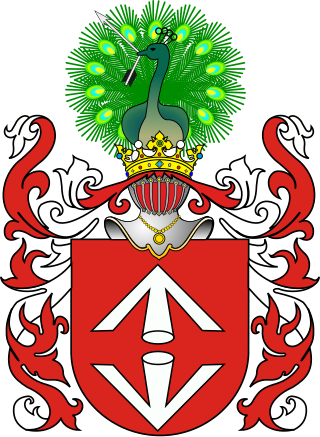
Bogoria is a Polish coat of arms. It was used by several szlachta families in medieval Poland and later under the Polish–Lithuanian Commonwealth, branches of the original medieval Bogoriowie family as well as families connected with the Clan by adoption.
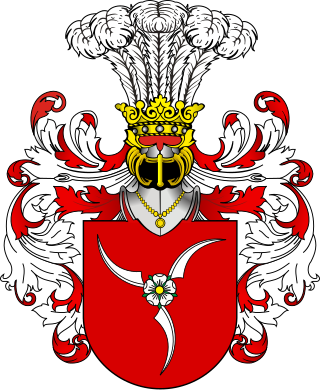
Rola is a Polish coat of arms. It was used by several szlachta families in the times of the Kingdom of Poland and Polish–Lithuanian Commonwealth.

Topór is a Polish coat of arms. It was used by several szlachta (noble) families in medieval Poland and under the Polish–Lithuanian Commonwealth.

Ogończyk is a Polish coat of arms. It was used by several szlachta families in the times of the Kingdom of Poland and the Polish–Lithuanian Commonwealth.

Korybut is a Polish coat of arms. It was used by the Princely House of Wiśniowiecki-Zbaraski and several branches of the House of Nieświcki in the times of the Polish–Lithuanian Commonwealth.
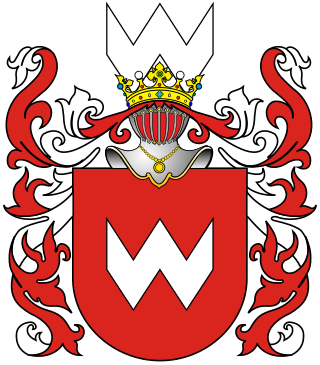
Abdank is a Polish coat of arms. It was used by several szlachta families in the times of the Kingdom of Poland and the Polish–Lithuanian Commonwealth.

Korab is a Polish coat of arms. It was used by many szlachta (noble) families under the Kingdom of Poland and the Polish–Lithuanian Commonwealth.

Alabanda is a Polish nobility coat of arms, used by several szlachta families in the times of the Kingdom of Poland.

Wieniawa is a Polish coat of arms. It was used by several noble, in Polish language szlachta families in the times of medieval Poland and the Polish–Lithuanian Commonwealth.

Hozyusz is a Polish coat of arms. It was used by several szlachta families.

Bełty is a Polish coat of arms.

Jeż is a Polish coat of arms.

Dąbrowa is a Polish coat of arms originated from the Duchy of Masovia.

Achinger is a Polish coat of arms. It was used by several szlachta families in the times of the Kingdom of Poland and the Polish–Lithuanian Commonwealth.

Bes(Bies, Bees, Beess) is a Polish coat of arms.

Alemani is a Polish nobility coat of arms originated from Italy.
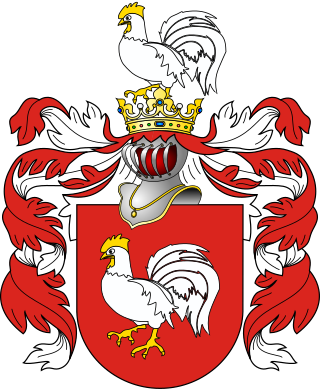
Kur is a Polish coat of arms. It was used by several noble families forming a Clan of Kur in the times of the Kingdom of Poland and the Polish–Lithuanian Commonwealth. It is noted during the reign of the Jagiellon dynasty and illustrated with its original name in the work of Bartosz Paprocki "Herby Rycerstwa Polskiego" in 1584. Furthermore, it is published in the work of Szymon Okolski in 1641. and several other publications
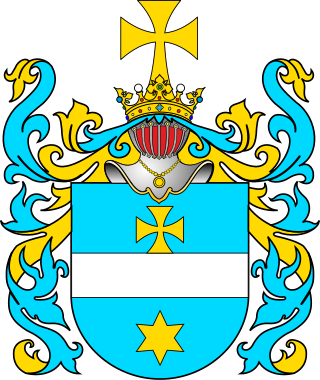
Krucina is a Polish coat of arms. It was used by the Korniakt family (szlachta) in the Polish–Lithuanian Commonwealth.